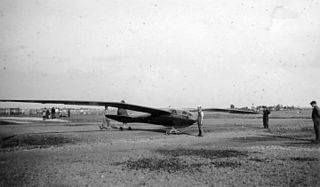
The Akaflieg Darmstadt D-7 Margarete, often shortened to Darmstadt D-7 Margarete, was one of the earliest two seat monoplane gliders, designed and built by German university students in 1923.
The Schneider Grunau 7 Moazagotl was a high-performance sailplane designed in Germany in 1933 specifically for fast, long distance flying using strong thermals. In 1937 it came second in the first World Gliding Championships, having previously made a flight of 300 km (186 mi).

The Nowotny N-y 4bis was a tandem two-seat light aircraft, built in Poland, as a step towards a very light, low-powered training aircraft for flying clubs. Its designer was killed in a glider soon after the first flight of his trainer and its development was abandoned.
The MIP Smyk, MIP from the initials of its Polish designers with Smyk meaning Brat or Kid, was an aerodynamically refined motor glider designed and built at Warsaw Technical University from 1935.

The Czerwiński CW 5bis was a Polish high performance sailplane, produced and developed between 1933 and 1935. It set several national records, competed at both national and international level and remained a Polish gliding club mainstay until the outbreak of World War II.
The Tarczyński and Stępniewki TS-1/34 Promyk was a Polish short span, high performance sailplane from the mid-1930s and was the first Polish sailplane equipped with flaps. Its construction was delayed by a financial crisis and its development terminated by World War II.

The Blaicher B-38 was a Polish, single seat sailplane completed in 1938. Notable for its use of long span Fowler flaps, its development was ended by the German invasion of Poland in September 1939.

The PWS-101 was a high performance Polish glider first flown in 1937. One made the longest distance glider flight in Europe in 1938, gathering prizes for aircraft and pilot.

The PWS-102 Rekin was a progressive development of the PWS-101, intended for cross-country flights. The prototype flew in an international contest in 1939 and the first of a projected production series was flown before the start of World War II.
The PWS-103 was a high performance, Polish 15 m span sailplane developed from the longer-span PWS-102 just before World War II.
The Warsztaty Lotnicze Czajka or Kocjan Czajka after its designer was a Polish secondary training glider which was in continuous production from 1931 to the start of World War II. More than 160 were completed.

The D.W.L. SG-21 Lwów was a Polish high performance sailplane built for the Polish government. Though both it and a development, the SG-28, were one-offs, they set several national records and led to the batch-produced Warsztaty Szybowcowe SG-3.
The Grzeszczyk SG-3 was a Polish single-seat, high performance sailplane first flown in 1933. Between 1934 and 1937 it was Poland's most successful competitor and record setter; about twenty-five were completed.
The Warsztaty Szybowcowe Sroka, or Kocjan Sroka after its designer, was a Polish intermediate training glider. About sixty were built between 1934 and 1939.
The Warsztaty Szybowcowe Mewa was a Polish, high performance, two seat sailplane flown in 1936 and built in small numbers.
The Warsztaty Szybowcowe SG-7 was a Polish high performance, single seat sailplane. Two prototypes flew in 1937 but, outperformed by their contemporaries, no more were built.
TheNaleszkiewicz & Nowotny NN 1 was an experimental high performance sailplane flown in Poland in 1931. Despite having advanced features, a disappointing performance led to its early abandonment.

The Naleszkiewicz-Nowotny NN 2 was a Polish primary glider first flown in 1931. An improved version followed in 1932 but only three were built in total.

The Rubik R-03 Szittya I was a Hungarian single-seat sailplane flown in the late 1930s. The design was developed through three improving variants. though only one of each was built.
The PZL M-3 Pliszka (Wagtail) was the first all-metal Polish glider. Three were built but its performance, particularly its glide ratio, was not good enough for it to be produced for Polish clubs.






















